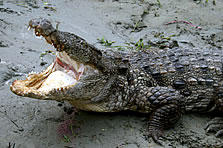
While 4m Great White Sharks have been taking surfers and divers off the South Australian Coast, it appears Crocodiles have declared war on humanity in the deep north.
A second person was taken by a crocodile within 5 days.
The following is the Reuters report on CNN:
SYDNEY, Australia (Reuters) -- A man is believed to have been killed by a large crocodile while scuba diving off Australia's remote north on Thursday, the second fatal crocodile attack in five days, police said.Who said life wasn't exciting in Australia?
The 56-year-old man was diving with a friend at Trepang Bay on the Cobourg Peninsula, north of tropical Darwin in the Northern Territory, when he was attacked.
The man had sustained injuries consistent with a crocodile attack. His body, which was recovered later on Thursday, was taken to Darwin for examination to determine the cause of death.
Police praised the man's unidentified friend who reported him missing after he failed to surface from a dive.
Despite the shock of the attack, the unidentified friend marked their exact location with a distress beacon before calling for help, which arrived several hours later. He told police he had seen a large crocodile in the area after the attack.
"Despite the pressure of the situation, the man did everything possible to help in the search for the diver," police acting superintendent Dean McMaster said in a statement.
"But for the quick actions of the man, the diver's body may never have been recovered," he said.
In a separate incident last Saturday, 37-year-old British engineer Russell Harris was killed by a large saltwater crocodile while he was snorkelling off Groote Eylandt, an island off the Northern Territory. Police found his body the next day.
About a dozen people have been killed by crocodiles in Australia in the past 20 years. In August, a 60-year-old man was dragged out of a canoe and killed by a crocodile in northeastern Queensland state.
Oh, Oh, Do I Spot Trouble?
The South China Sea gas fields is on of the many issues festering between mainland China and Japan. Japan wants to test-drill th site that is under dispute between the two nations. Thos emissile frigates that China were showing off a few days are directly related to its desire to push its influence across the sea. Problem is, the actual fields are in international waters, so you can see a stoush over this coming up.
Here's the Sankei newspaper report:
妨害行動に手立てなく
東シナ海の石油ガス田開発に関する日中協議が開かれる中、日本企業による試掘に向けた政府の安全確保対策は遅々として進んでいない。中国側と対等な立場で交渉するには「日本側が試掘に着手するのが前提」(民間企業幹部)にもかかわらず、中国側の示威的な軍事行動に対抗する法整備を先送りしてきたためだ。偶発的な“武力衝突”の可能性も否定できない中、日本側が試掘に踏み切った場合に中国側がどう出るか、シミュレーションしてみた。(杉本康士)
◆中国の圧力
日中中間線付近での日本側の調査に対し、中国側はこれまで、漁船を装った“工作船”が拡声器で大音量を流し、音波調査を繰り返し妨げていた。
しかし、今年に入って妨害活動は民間船主体から、国の艦船によるものへとエスカレート。国家海洋局の調査船が、日本の調査船の前方を至近距離で横切る危険な航行で妨害したほか、九月にはミサイル駆逐艦一隻、フリゲート艦二隻、洋上補給艦、情報収集艦の計五隻が、中間線付近の中国側海域で活動しているのを海上自衛隊の対潜哨戒機P3Cが確認した。
こうしたことから、政府から試掘権を得た帝国石油が試掘に踏み切った場合、漁船や調査船に加え、沿岸警備隊の船舶や海軍艦艇、軍用機が、(1)日本の調査船の周囲を航行して心理的な圧力をかける(2)進路を妨害したり、体当たりしたりする物理的な妨害(3)射撃による強制的な排除−といった行動に出ることが予想される。
◆偶発的衝突も
中国海軍は東シナ海を対象とした予備役の船艇大隊を編成したとされ、東シナ海には緊張が高まっている。中越両国が二〇〇〇年末に海上国境に関する協定を締結したトンキン湾では、今年に入って両国の漁船と治安当局の銃撃戦が発生した。
拓殖大の茅原郁生教授(中国政治)は、トンキン湾では両国が海軍力を展開してにらみ合いながらも、中国側が直接排除行動には出ていないことを挙げ、「中国政府は東シナ海でも慎重姿勢をとる」とみる。ただ、「中国海軍の現場指揮官が緊張状態の中で独断専行し、交戦状態になることもありうる」とも述べており、“最悪のケース”も否定できない。
中国軍艦による示威行動への対抗策をめぐっては、専門家の間でも意見が分かれている。
中国軍事問題研究家の平松茂雄氏は「日本側は政治判断で自衛隊の船を出すことが必要だ」と指摘。これに対し、海洋政策研究財団の秋山昌広会長(元防衛事務次官)は、中国側の強圧的な姿勢を逆に際立たせる意味で、「中国による示威行動程度であれば、海上自衛隊が出ていく必要はない」との立場だ。
◆法整備が急務
中国は中間線の日本側海域も自国の排他的経済水域(EEZ)内との立場をとっており、試掘に向けた日本側の調査活動に対する妨害ばかりではなく、中間線の日本側海域で試掘を行う事態も想定される。
秋山氏によると、中国船の体当たりなどで日本船が危険にさらされた場合、船舶往来妨害罪や器物損壊罪で取り締まることは可能だ。国連海洋法条約は、EEZ内で外国船舶を拿捕(だほ)する「追跡権」を認めている。
しかし、日本の場合はあくまで領土・領海内での違法行為を取り締まる領海法しかなく、有効な手立てがないのが実情。九月二十二日の自民党海洋権益特別委員会では、石破茂元防衛庁長官が「自衛隊にはEEZ内で活動するための法律がなく、実際は何もできない」と法の未整備を指摘した。
谷川秀善外務副大臣は九月二十九日の記者会見で、ガス田問題をめぐる政府の対応について、「こっちはちょっと弱腰みたいな点があった」と指摘し、これまで後手に回りすぎたとの認識を示した。秋山氏は「結果的に中国側が望む海域での共同開発に持ち込まれる危険性がある」と今後の推移を危惧(きぐ)している。
■中間線、当事国の合意で規定/日本の主張、世界の主流
一九九四(平成六)年に発効した国連海洋法条約は、海岸から二百カイリ(約三百七十キロ)の範囲を排他的経済水域(EEZ)と定めている。ただ、東シナ海での日本と中国のように双方からの二百カイリの範囲が重なる場合は、当事国の合意で定めると規定。EEZ内では石油や天然ガスの探査・開発、漁業などに主権的権利を持つ。
中国は、中国大陸から沖縄トラフ(尖閣諸島と久米島間の海溝)の端まで大陸棚が続くとの自然延長論に立ち、この海域を自国のEEZと主張。これに対し、日本は両国が同じ大陸棚にあり、両国の二百カイリの中間線が境界になると主張してきた。
八五年六月、リビアとマルタの大陸棚をめぐる争いで、国際司法裁判所は「大陸棚の自然延長論を適用することができない」との判決を下し、「中間線論を唱える日本の主張が世界の主流」(外務省筋)となっている。
国連海洋法条約では、EEZが重なり合う場合でも二百カイリ以内に潜在的権利を認めているが、日本は潜在的権利に関する主張を封印、中国側に配慮を示してきた経緯がある。このため、東シナ海全域の共同開発を求める理由として、中国が日中中間線の中国側海域で開発している石油ガス田の地下構造が日本側海域に続いている可能性が高いことを挙げている。
The long and short of it is that China doesn't really recognise international treaties covering ocean territories, while Japan is insisting on its claims based on international agreements it has signed and backed. They're saying they don't recognise that there is a neutral zone to be negotiated - it's all theirs according to their 'diplomats'. So they've sent warships into the seas.
On the other hand, Japanese commercial interests are pushing the Japanese government very hard to resolve security issues as they go forwards; they're in a hurry to explore those gas fields. So the pressure on this situation is only going to mount as the two nations stare off at each other. Especially so, after this year's hoohah about history text books.
This is reminiscent of the way the 1895 Sino-Japanese war started, with China sending two battleships to Japan to show off her navy. I do hope we're not seeing history repeating.

No comments:
Post a Comment